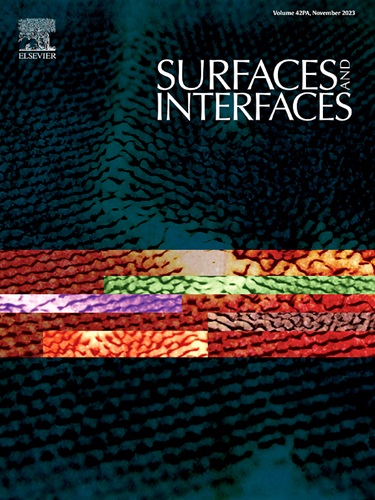Low temperature synthesis of yellow-green emission carbon dots with excellent antibacterial activity for Escherichia coli and Methicillin-resistant Staphylococcus aureus
IF 6.3
2区 材料科学
Q2 CHEMISTRY, PHYSICAL
引用次数: 0
Abstract
Human life is seriously threatened by the development of antibiotic-resistant microorganisms. The most promising antibacterial agents for dormant pathogenic among the range of nanomaterials are carbon dots. This work proposes a fast and environmentally friendly method for preparing yellow-emission carbon dots (YCDs), which could be completed within 30 min at 80 °C by using ascorbic acid and cetylpyridinium chloride monohydrate as precursors. Crucially, the obtained YCDs could be easily internalized by bacteria and emit bright yellow-green light inside the cells due to the small size (3.9 ± 0.6 nm) and large stokes shift (161 nm). Additionally, the YCDs display excellent effectiveness against pathogenic bacteria, especially for Gram-negative and resistant Gram-positive bacteria. The minimum inhibitory concentration for methicillin-resistant Staphylococcus aureus (MRSA) and Escherichia coli are 1.25 and 5 μg mL−1, respectively. Furthermore, results demonstrate that the excellent antibacterial ability of YCDs is attributed to a combination of the hydrophobic of alkyl chain, oxidative damage and electrostatic interaction. Overall, our work provides an environmentally friendly and low-cost method to prepare the yellow-green emission carbon dots with strong antibacterial activity against resistant bacteria.

低温合成对大肠杆菌和耐甲氧西林金黄色葡萄球菌具有良好抑菌活性的黄绿色发射碳点
耐抗生素微生物的发展严重威胁着人类的生命。在纳米材料中,碳点是最有前途的潜伏致病菌抗菌剂。本工作提出了一种快速、环保的制备黄排放碳点(YCDs)的方法,该方法以抗坏血酸和十六烷基吡啶一水合物为前驱体,在80℃下30 min内完成。重要的是,所获得的YCDs由于尺寸小(3.9±0.6 nm)和斯托克斯位移大(161 nm),很容易被细菌内化,并在细胞内发出明亮的黄绿色光。此外,YCDs对致病菌,特别是革兰氏阴性菌和耐药革兰氏阳性菌表现出优异的抑菌效果。对耐甲氧西林金黄色葡萄球菌(MRSA)和大肠杆菌的最低抑菌浓度分别为1.25和5 μ mL−1。此外,研究结果表明,YCDs具有优异的抗菌能力是由于烷基链的疏水性、氧化损伤和静电相互作用的综合作用。总之,我们的工作提供了一种环境友好、低成本的方法来制备对耐药菌具有强抗菌活性的黄绿色碳点。
本文章由计算机程序翻译,如有差异,请以英文原文为准。
求助全文
约1分钟内获得全文
求助全文
来源期刊

Surfaces and Interfaces
Chemistry-General Chemistry
CiteScore
8.50
自引率
6.50%
发文量
753
审稿时长
35 days
期刊介绍:
The aim of the journal is to provide a respectful outlet for ''sound science'' papers in all research areas on surfaces and interfaces. We define sound science papers as papers that describe new and well-executed research, but that do not necessarily provide brand new insights or are merely a description of research results.
Surfaces and Interfaces publishes research papers in all fields of surface science which may not always find the right home on first submission to our Elsevier sister journals (Applied Surface, Surface and Coatings Technology, Thin Solid Films)
 求助内容:
求助内容: 应助结果提醒方式:
应助结果提醒方式:


